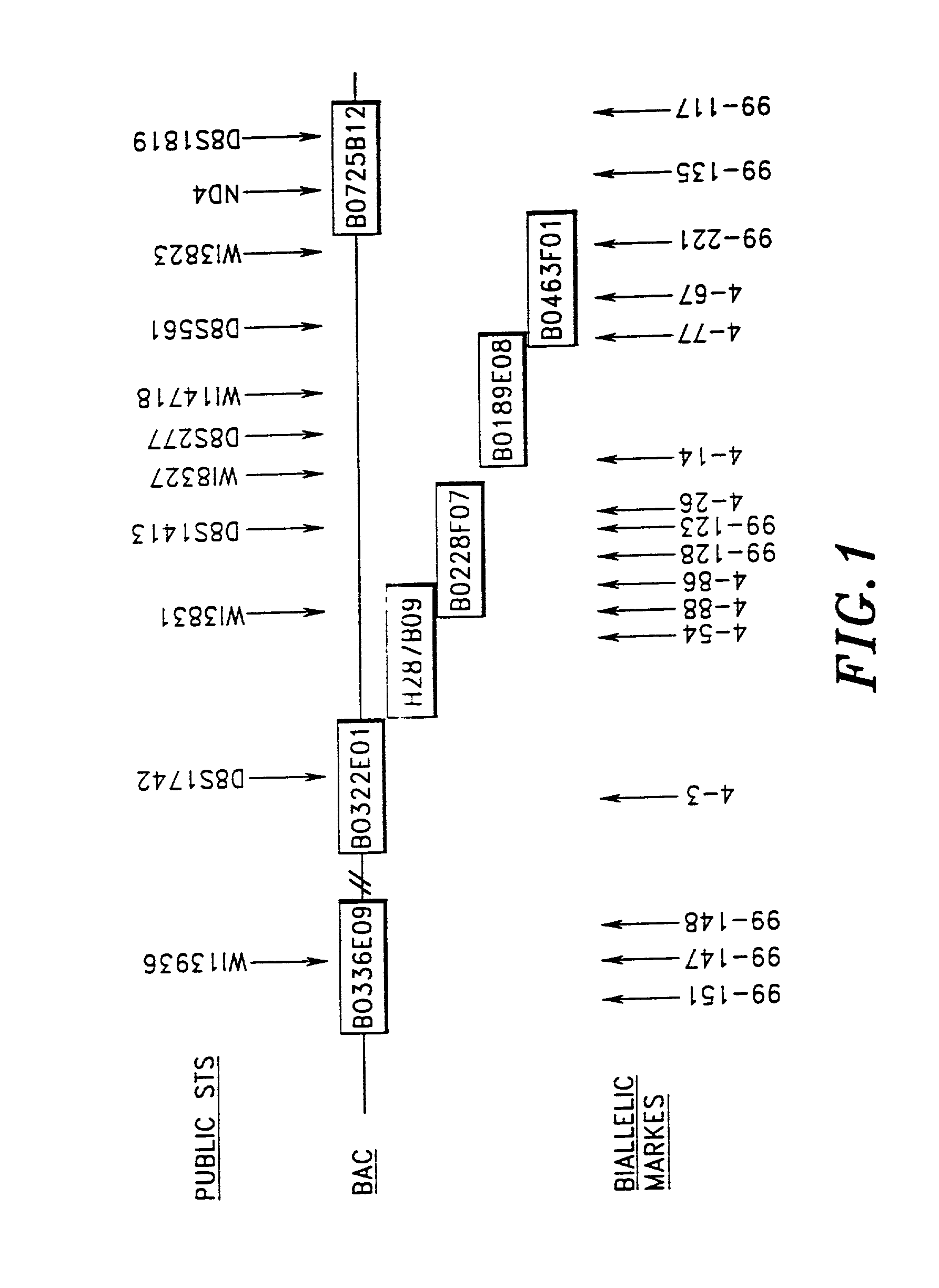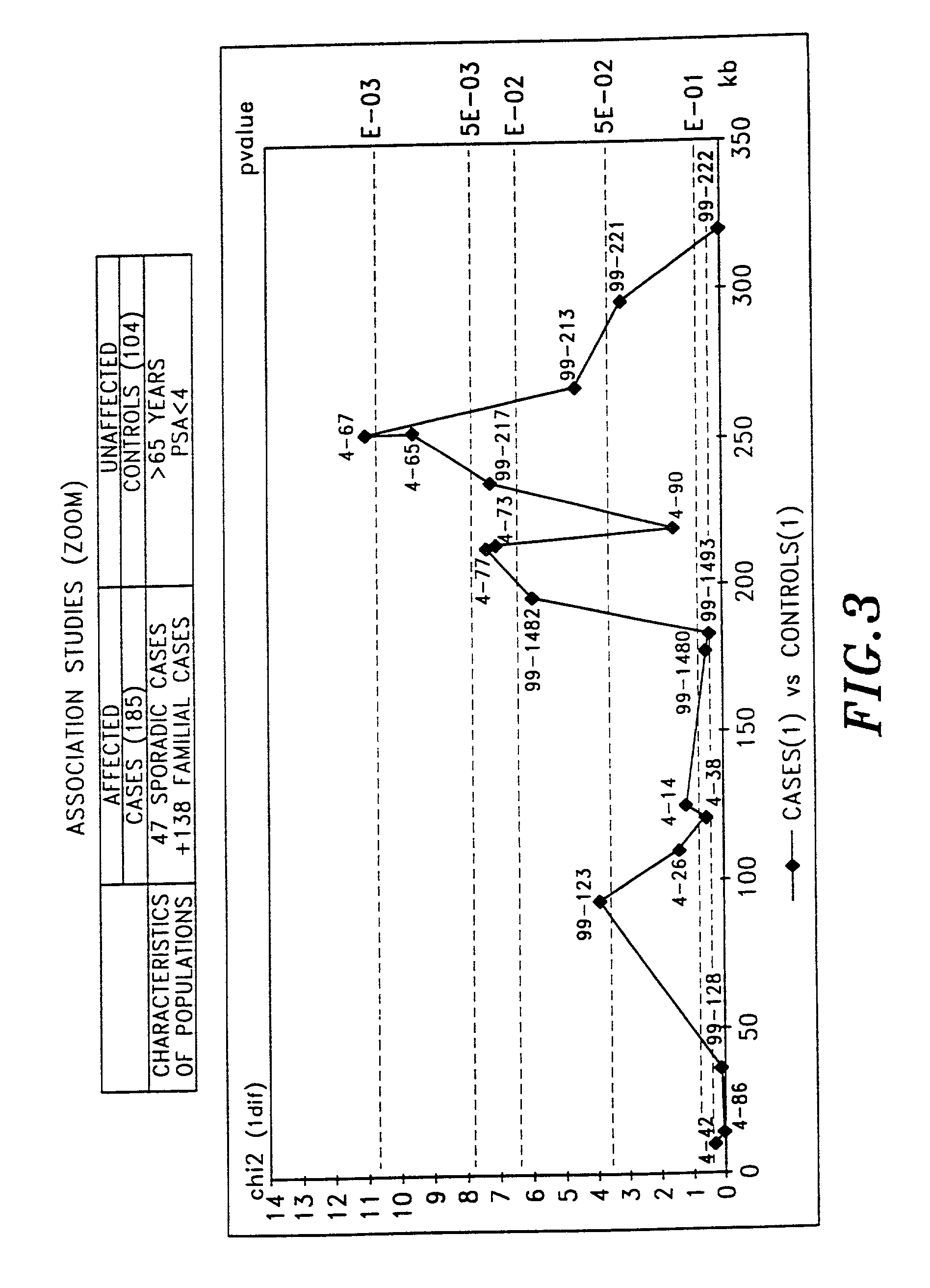Prostate cancer gene
a prostate cancer and gene technology, applied in the field of prostate cancer gene, can solve the problems of limiting the detection power of this technique, preventing the mutation carrier from being exposed to an increased risk of cancer, and only being able to investigate oncogenes in tumor tissues
- Summary
- Abstract
- Description
- Claims
- Application Information
AI Technical Summary
Benefits of technology
Problems solved by technology
Method used
Image
Examples
example 1
[0151]The cells obtained from three liters overnight culture of each BAC clone were treated by alkaline lysis using conventional techniques to obtain the BAC DNA containing the genomic DNA inserts. After centrifugation of the BAC DNA in a cesium chloride gradient, ca. 50 μg of BAC DNA was purified. 5–10 μg of BAC DNA was sonicated using three distinct conditions, to obtain fragments of the desired size. The fragments were treated in a 50 μl volume with two units of Vent polymerase for 20 min at 70° C., in the presence of the four deoxytriphosphates (100 μM). The resulting blunt-ended fragments were separated by electrophoresis on low-melting point 1% agarose gels (60 Volts for 3 hours). The fragments were excised from the gel and treated with agarase. After chloroform extraction and dialysis on Microcon 100 columns, DNA in solution was adjusted to a 100 ng / μl concentration. A ligation was performed overnight by adding 100 ng of BAC fragmented DNA to 20 ng of pBluescript II Sk (+) ve...
example 2
[0153]The subclone inserts were amplified by PCR on overnight bacterial cultures, using vector primers flanking the insertions. The insert extremity sequences (on average 500 bases at each end) were determined by fluorescent automated sequencing on ABI 377 sequencers, with a ABI Prism DNA Sequencing Analysis software (2.1.2 version).
[0154]The sequence fragments from BAC subclones were assembled using Gap4 software from R. Staden (Bonfield et al. 1995). This software allows the reconstruction of a single sequence from sequence fragments. The sequence deduced from the alignment of different fragments is called the consensus sequence. We used directed sequencing techniques (primer walking) to complete sequences and link contigs.
[0155]FIG. 1 shows the overlapping BAC subclones (labeled BAC) which make up the assembled contig and the positions of the publicly known STS markers along the contig.
Identification of Biallelic Markers Lying Along the BAC Contig
[0156]Following assembly of the B...
example 3
[0160]The population used in order to generate biallelic markers in the region of interest consisted of ca. 100 unrelated individuals corresponding to a French heterogeneous population.
[0161]DNA was extracted from peripheral venous blood of each donor as follows.
[0162]30 ml of blood were taken in the presence of EDTA. Cells (pellet) were collected after centrifugation for 10 minutes at 2000 rpm. Red cells were lysed by a lysis solution (50 ml final volume: 10 mM Tris pH7.6; 5 MM MgCl2; 10 mM NaCl). The solution was centrifuged (10 minutes, 2000 rpm) as many times as necessary to eliminate the residual red cells present in the supernatant, after resuspension of the pellet in the lysis solution.
[0163]The pellet of white cells was lysed overnight at 42° C. with 3.7 ml of lysis solution composed of:[0164]3 ml TE 10-2 (Tris-HCl 10 mM, EDTA 2 mM) / NaCl 0.4 M[0165]200 μl SDS 10%[0166]500 μl K-proteinase (2 mg K-proteinase in TE 10-2 / NaCl 0.4 M).
[0167]For the extraction of proteins, 1 ml sat...
PUM
 Login to View More
Login to View More Abstract
Description
Claims
Application Information
 Login to View More
Login to View More - R&D
- Intellectual Property
- Life Sciences
- Materials
- Tech Scout
- Unparalleled Data Quality
- Higher Quality Content
- 60% Fewer Hallucinations
Browse by: Latest US Patents, China's latest patents, Technical Efficacy Thesaurus, Application Domain, Technology Topic, Popular Technical Reports.
© 2025 PatSnap. All rights reserved.Legal|Privacy policy|Modern Slavery Act Transparency Statement|Sitemap|About US| Contact US: help@patsnap.com



